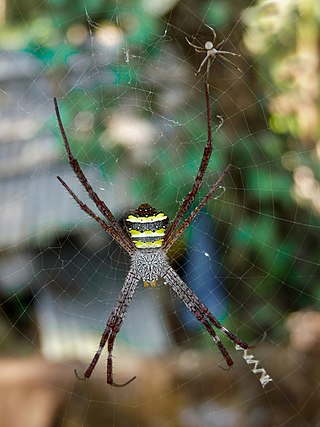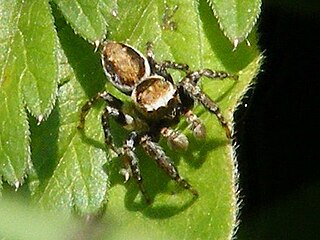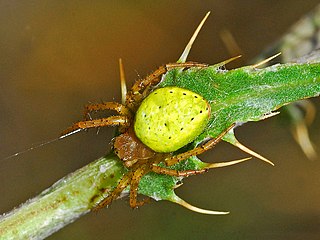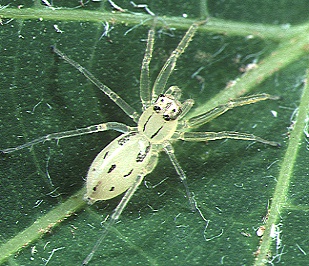
Argiope protensa, commonly known as the tailed grass spider or teardrop spider, is a species of spider in the orb weaver family, Araneidae. This species is fairly common and widespread in Australasia, but like many spider species, little is known of its ecology, biology, or life history.

Zygoballus sexpunctatus is a species of jumping spider which occurs in the southeastern United States where it can be found in a variety of grassy habitats. Adult spiders measure between 3 and 4.5 mm in length. The cephalothorax and abdomen are bronze to black in color, with reddish brown or yellowish legs. The male has distinctive enlarged chelicerae and front femora. Like many jumping spiders, Z. sexpunctatus males exhibit ritualized courtship and agonistic behavior.

Argiope pulchella is a species of the orb-weaver spider family, Araneidae. Its range extends from India to China, Indochina, and Sumatra. It is a synanthropic species, often living in habitats associated with humans.

Rugathodes sexpunctatus is a minute species of spider in the family Theridiidae, the cobweb or tangle-web spiders. This family includes the medically important genus Latrodectus—the widow spiders. The species in the genus Rugathodes are too small to be dangerous to humans. Very little is known about most species in this genus.

Cyrtophora parangexanthematica is a species of tent spider found in the Philippines. Its scientific name comes from its close resemblance to double-tailed tent spiders. It was described from a single female specimen collected in 1995.

Araneus mitificus, commonly known as the kidney garden spider or pale orb weaver is a species of orb-weaver spider found in South, East, and Southeast Asia.

Mexcala synagelese is a species of jumping spider in the genus Mexcala that lives in Angola, Democratic Republic of the Congo, Ivory Coast, Nigeria and Sudan. The spider was first defined in 2009 by Wanda Wesołowska, one of over 500 that the arachnologist described during her career. It mimics ants and ant-like wasps, living alongside and preying upon them. The spider is medium-sized, with a dark brown carapace between 2.7 and 3.2 mm long and a pale brown to dark brown abdomen between 3.2 and 4.0 mm long. The male has three strips on its abdomen while the female has a more complex pattern of dark bands and light patches. The spider has long thin brown legs. It has good eyesight, which it uses when hunting and also during courtship. The male palpal bulb has a long tibial apophysis, or spike, that curves in towards the bulb. The female epigyne has two shallow depressions and short seminal ducts that lead to long receptacles.

Pseudomogrus mirandus is a species of jumping spider in the genus Pseudomogrus. It has been found in Turkmenistan on the steppe, although it may also live in Afghanistan and Iran. The species was first defined by Wanda Wesołowska in 1991, one of over 500 described by the arachnologist. She originally placed it in the genus Yllenus, but was moved to the new genus Logunyllus in 2016, and then to its present designation in 2019. The spider is small, with a carapace measuring between 1.6 and 1.78 mm long and an abdomen between 1.4 and 2.3 mm long. The male has a red-brown or dark brown carapace and dark grey abdomen, the female a brown carapace and greyish-brown abdomen. All have a covering of small white scales. The spider has yellow legs. The copulatory organs are distinctive and enable the spider to be distinguished from others in the genus. The female epigyne has a half-moon-shaped pocket and simple insemination ducts that lead to spherical spermathecae. The male lacks the ventral tibial apophysis common in other species and has a compound terminal apophysis that is of a similar length to its thin embolus.

Menemerus regius is a species of jumping spider in the genus Menemerus that lives in Ethiopia. The species was first identified in 1999 by Wanda Wesołowska. The spider has been found living in low vegetation, on trees and in houses. It is small, with a brown hairy carapace that is between 1.9 and 2.4 millimetres long and a yellowish-grey or greyish-beige abdomen that is between 2.1 and 3.0 millimetres in length. The female is slightly larger than the male. The carapace has a large yellowish patch and the abdomen a stripe down the middle. The spider has yellow legs. The spider is similar to others in the genus. However, its copulatory organs are distinctive. The male lacks the ventral tibial apophysis normally found on its palpal bulb and instead has an unusual double tibial apophysis with one bulbous appendage and the other shaped like a horn. The female has a characteristic shape to its epigyne with two rounded depressions to the front and a noticeable notch to the rear.

Pseudicius adustus is a species of jumping spider in the genus Pseudicius that is endemic to Namibia. The spider was first defined in 2016 by Wanda Wesołowska. The spider is small, with an oval carapace typically 1.8 mm (0.07 in) long and an abdomen 2.6 mm (0.10 in) long. The abdomen is elongated like other members of the genus, but with a yellowish with a pattern of eight brown patches. The female has an ovoid epigyne that has a large deep central depression and short wide insemination ducts. The design of the epigyne helps distinguish it from related species, like Pseudicius solitarius, which has larger receptacles and longer insemination ducts. It can also be most identified by the pattern on its abdomen. The male has not been described.

Evarcha awashi is a species of jumping spider in the genus Evarcha that lives in Ethiopia. The species was first described in 2008 by Wanda Wesołowska and Beata Tomasiewicz. The spider is small, with a cephalothorax measuring between 2.0 and 2.3 mm long and an abdomen between 1.9 and 2.4 mm long. The male and female are similar in size but differ slightly externally. The male carapace is orange while the female is brown, both with a darker eye field. The pattern on the abdomen is generally similar, a combination of light background and dark patches, but the female has less contrast between the two. The legs are mainly brown with yellowish tarsi. Its copulatory organs are distinctive. The male has a short embolus that follows the palpal bulb and a sharp tooth on its short wide and blunt protrusion on its palpal tibia, or tibial apophysis. The female has insemination ducts that narrow into multi-chambered spermathecae.

Pseudomogrus knappi is a species of jumping spider in the genus Pseudomogrus that lives in Sudan and Yemen. The species was first defined by Wanda Wesołowska and Antonius van Harten in 1994. They originally placed it in the genus Yllenus, but it was moved to the new genus Logunyllus in 2016, and then to its present designation in 2019. The spider is medium-sized, with a carapace that is between 2.01 and 2.1 mm long and an abdomen between 2.93 and 3.1 mm long. The male has not been described. The female has a plain brown or yellow-brown carapace and an indistinct pattern of stripes on its yellow or yellowish-grey abdomen. It has yellow legs. The spider can be identified by its copulatory organs. It has a very simple internal structure inside its epigyne with short insemination ducts.

Evarcha arabica is a species of jumping spider in the genus Evarcha that lives in Yemen. The species was first described in 2007 by Wanda Wesołowska and Antonius van Harten. The spider is small, with a carapace that measures between 2.1 and 2.7 mm long and an abdomen that is between 1.8 and 3.2 mm long. The female is generally larger and lighter than the male. The spider's eye field is darker. The top of the male abdomen is blackish-brown with a pattern of white dots and a large yellowish-orange belt. The top of the female abdomen has similar white dots but is mainly yellow with small darker dots. The male's legs are brown and yellow while the female's are orange to yellow. It has distinctive copulatory organs. The female has accessory glands near the copulatory openings and simple bean-like spermathecae. The male has a thin embolus and a tibial apophysis that has a forked tip.

Araniella opisthographa is a species of orb weaver in the spider family Araneidae.

Araneus grossus is a orb-weaver spider species. The species is one of the largest orb-weaver spiders in Europe. It is found in South and Southeast Europe and Central Asia.
Exechocentrus lancearius is a species of spider in the orb-weaver spider family Araneidae, found only in Madagascar. It was initially described from a partial specimen of an adult female. The first description of a complete specimen and its prey-catching behaviour was published in 2012. E. lancearius is a bolas spider. Rather than using a web, adult females catch their prey by using a line with one or two sticky drops which they swing.

Ordgarius sexspinosus is a species of spider in the orb-weaver spider family Araneidae, found from India to Japan and Indonesia. O. sexspinosus is a bolas spider. Rather than using a web, adult females catch their prey by using a line with one or two sticky drops which they swing.
Parabomis wandae is a species of crab spider in the genus Parabomis that lives in Ghana, Ivory Coast, Kenya and Rwanda. The species was first described in 2020 by Ansie Dippenaar-Schoeman and Stefan Foord. It thrives in rainforests. The spider is very small, with a total length between 1.9 and 2.26 mm. The female is larger and lighter in colour than the male. It has a distinctive hump to the abdomen, which for the female is less pronounced. The female abdomen has dark patches and spots on its white surface, while the male has a brown shell. The species can be differentiated from other members of the genus by its copulatory organs. The male has a distinctive beak-like end of the retrolateral tibial apophysis. The female has an egg-shaped epigyne with long copulatory ducts.

Asemonea murphyae is a species of jumping spider in the genus Asemonea that lives in Kenya and South Africa. First defined in 1980 by Fred Wanless, the spider is named after the British arachnologist Frances M. Murphy. Asemonea murphyae thrives in a wide range of environments, particularly by the side of rivers, streams and tracks. A small spider, with a carapace that is between 1.48 and 2.00 mm long and an abdomen between 2.4 mm long, it is generally yellow with a green tint that enables it to blend into its environment. The female is smaller than the male. The species can be distinguished from other spiders in the same genus by the design of the female's epigyne and the male pedipalp, particularly the male's forked spike on the palpal tibia.

Salsa fuliginata, commonly known as the sooty orbweaver, is a orb-weaver spider of Araneidae in the genus Salsa. The species is found throughout southeastern Australia and New Zealand.


















